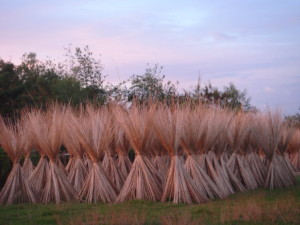8 Undeniable Eco-Friendly Qualities of Jute
Should I use a bag for life or just reuse my plastic shopping bags? What kind of re-useable bags should I be using; plastic, cotton, hessian?
If you take an interest in the environmental impact of your lifestyle then there’s a good chance you’ve asked yourself these questions at some point in your life. Or, perhaps, you ask yourself them all the time.

Unfortunately, there’s no simple answer. The manufacturing of re-usable bags has a much higher environmental impact – raw materials, fuel and energy used – than plastic bags. This means that if you opt for a bag-for-life then you’ve really got to be using it in excess of 100 times before it can be considered more eco-friendly than a disposable plastic bag.
Despite this, there’s no denying that disposable plastic bags are a serious problem. If you do have any doubts about the harm caused by disposable bags just cast your eyes over the facts below:
- In excess of 1 trillion plastic bags are used worldwide every year
- A single plastic bag can take 500+ years to degrade and is likely to contaminate soil and waterways in doing so
- 10% of plastic bags produced end up in the ocean, 70% of which find their way to the ocean floor where they are likely to never degrade. Plastic bags in our seas cause the death of many marine animals (turtles, fish, cetaceans) when they are mistaken for food
So, why Jute?

Jute fibre is made from the outer stem and skin of the jute plant, is prized for its versatility and is most well known for its use in burlap and hessian cloth. You may not even have heard of jute. Its production declined in the 1950s and is only just seeing a resurgence in popularity as consumers demand greener, more sustainable products.
Beyond jute’s other qualities, there are a whole host of reasons why jute is considered an environmentally friendly option:
- Jute reaches maturity in less than 6 months and offers large crop yield for the area of land it’s grown upon. This efficiency of growth means less land is required compared to other crops and therefore reduces the need to encroach upon wilderness and natural habitats.
- Jute can be grown without the need to use pesticide or fertiliser. Where these chemicals are used Jute requires very little of them compared to other crops
- Jute absorbs carbon dioxide from the atmosphere and releases oxygen at a rate much higher than most trees
- Jute cultivation actually enhances soil fertility for future crops
- The woody core of the jute plant (called hurd) has the potential to meet the majority of the world’s wood needs. Underutilised at the moment, jute hurd could play a key role in the reduction of deforestation.
- Jute fibre is entirely bio-degradable and compostable.
- Jute fibre is recyclable
- Jute bags are hard-wearing and can be used again and again, negating the need to use plastic carrier bags
It’s clear that, despite the initial outlay required to produce re-usable bags, if used as they should be they are an extremely viable alternative to harmful plastic bags. In addition to this, of the materials available for manufacture of these bags, Jute’s environmental qualifications are impressive. If you do decide to opt for re-usable bags, you can’t go far wrong with a bag made from jute – a fibre with undeniable eco credentials.
Author Bio:
 When John isn’t out surfing or trying to save the ocean he’s writing environmentally motivated content for Bags of Ideas, a bespoke promotional bag producer based in the UK.
When John isn’t out surfing or trying to save the ocean he’s writing environmentally motivated content for Bags of Ideas, a bespoke promotional bag producer based in the UK.




Great Post..Thanks for sharing
Hey, Mr. John.
I hope you’re doing well. I came across your blog post “8 Undeniable Eco-Friendly Qualities of Jute” and was impressed by its informative content. As the owner of EcoJuteBags.com, a website promoting eco-friendly alternatives like jute bags, I believe our interests align perfectly.
I propose a collaboration where we combine our environmental knowledge to create valuable content. By sharing my expertise on eco jute bags and their role in combating plastic pollution, we can enhance our articles and increase our website rankings. It would be an honor if you could include a backlink to EcoJuteBags.com in your blog post.
Let me know your thoughts on this collaboration, and I look forward to working together for a greener future.
Best regards,
Rai Zulfiqar Ali